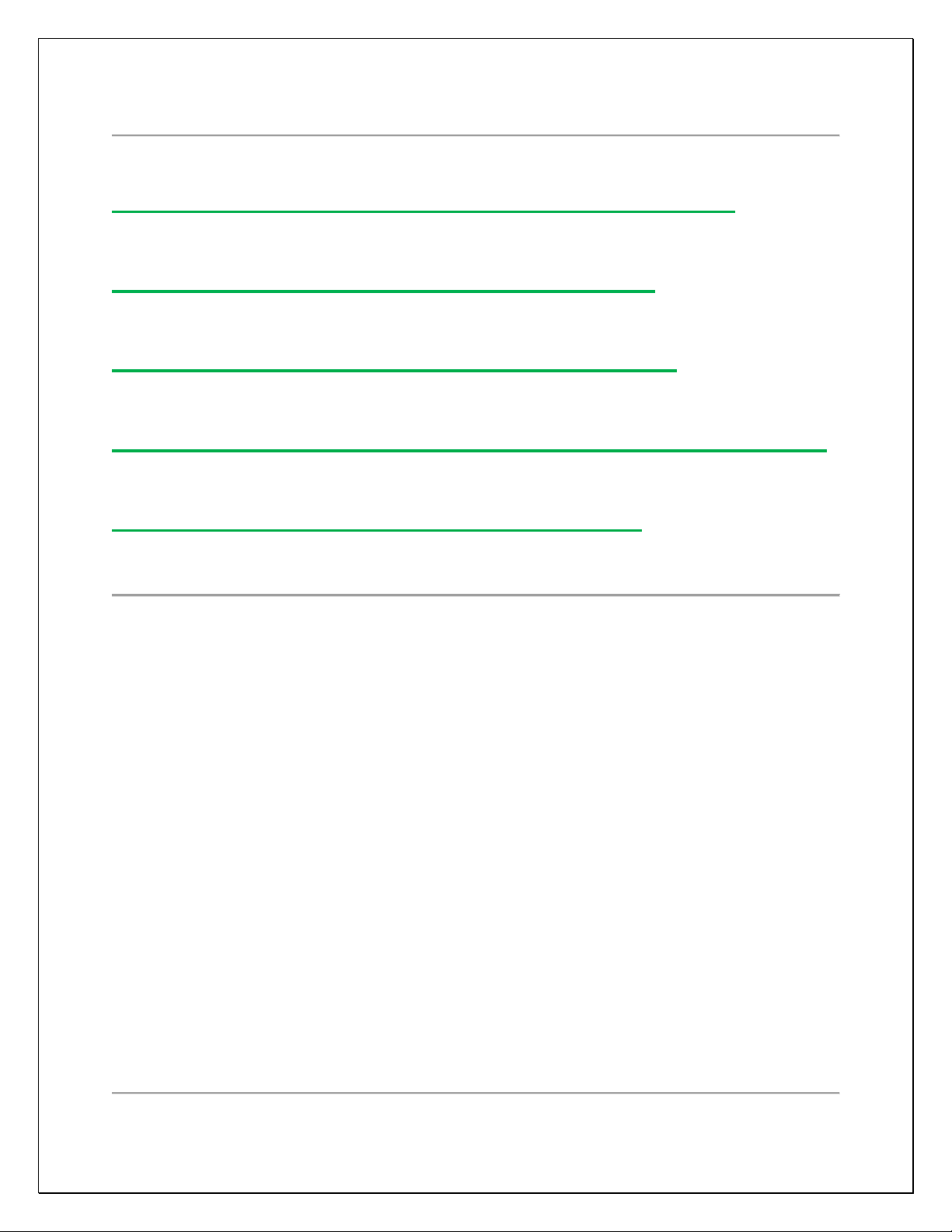
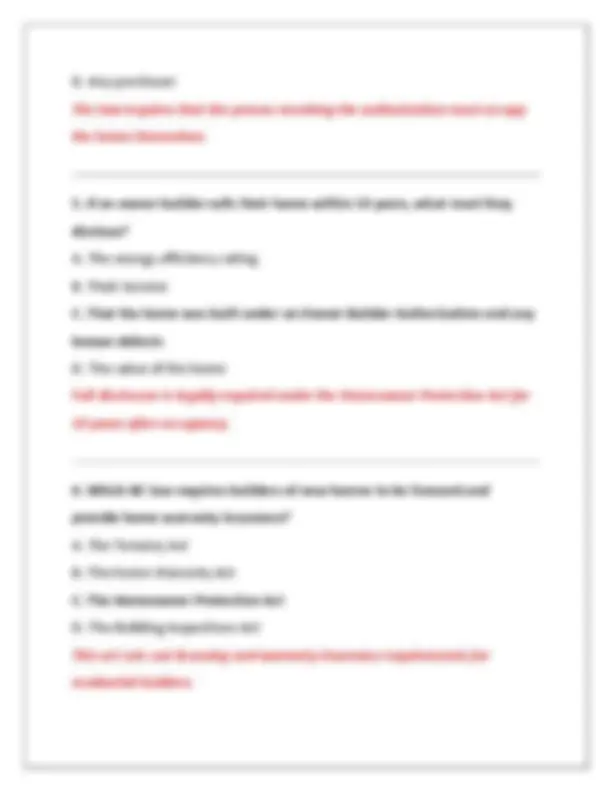
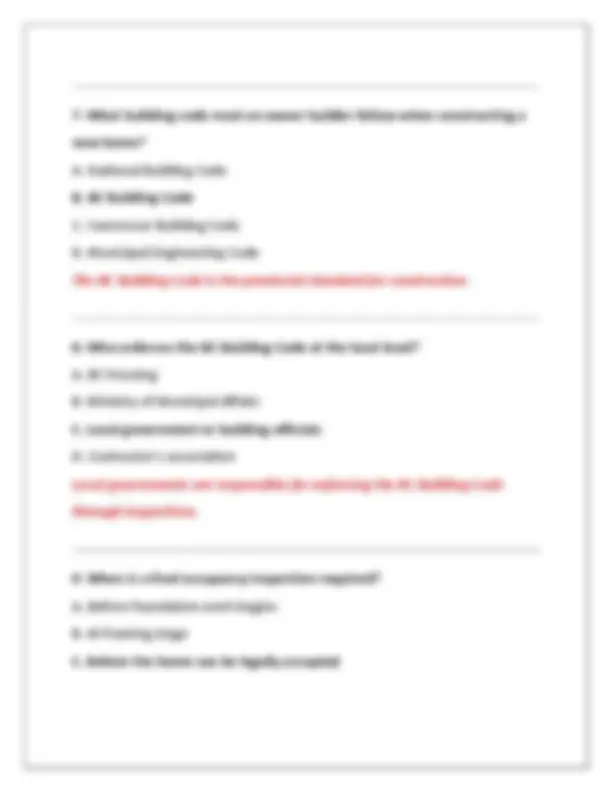
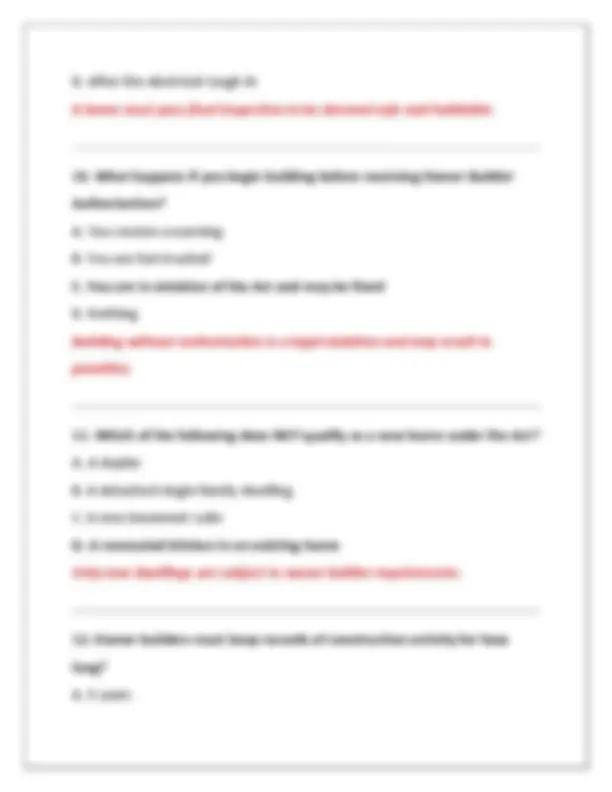
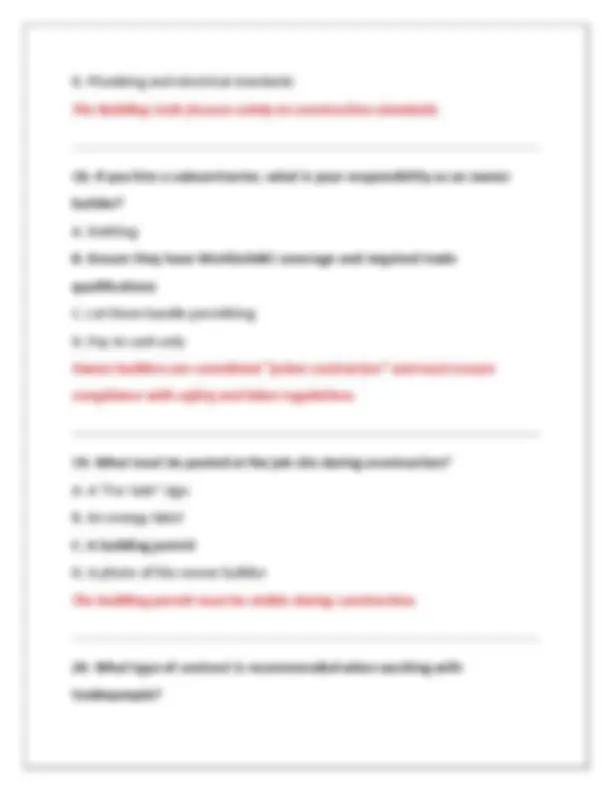
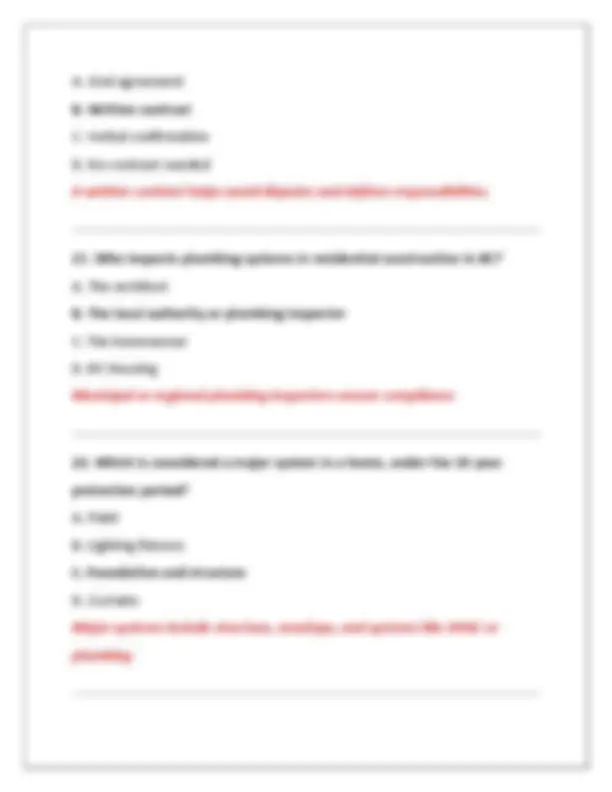
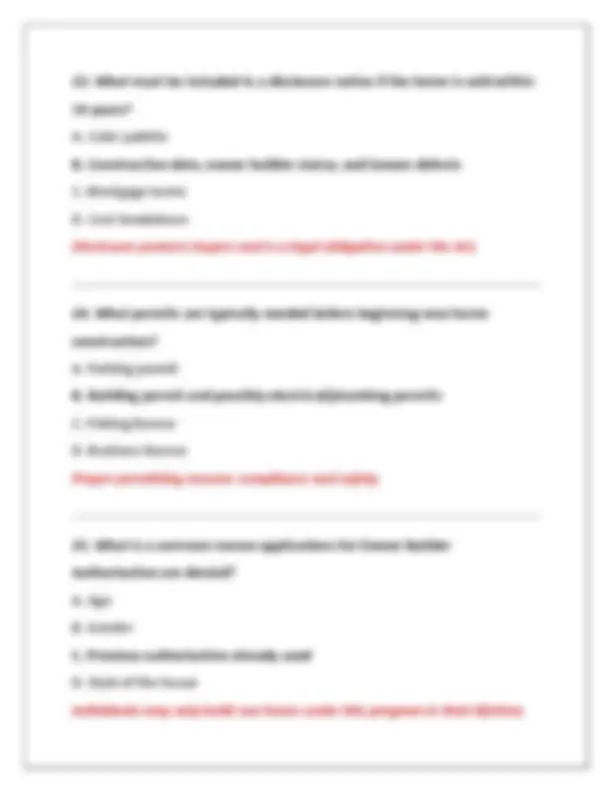
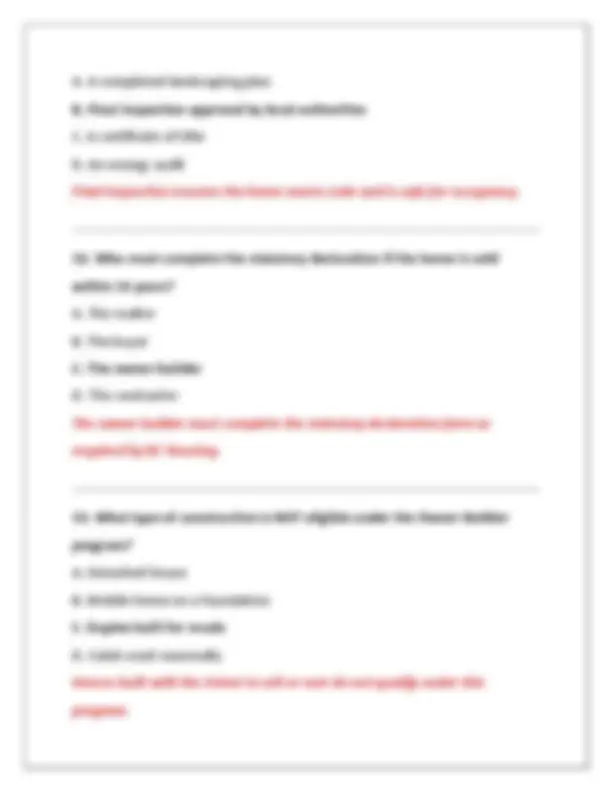
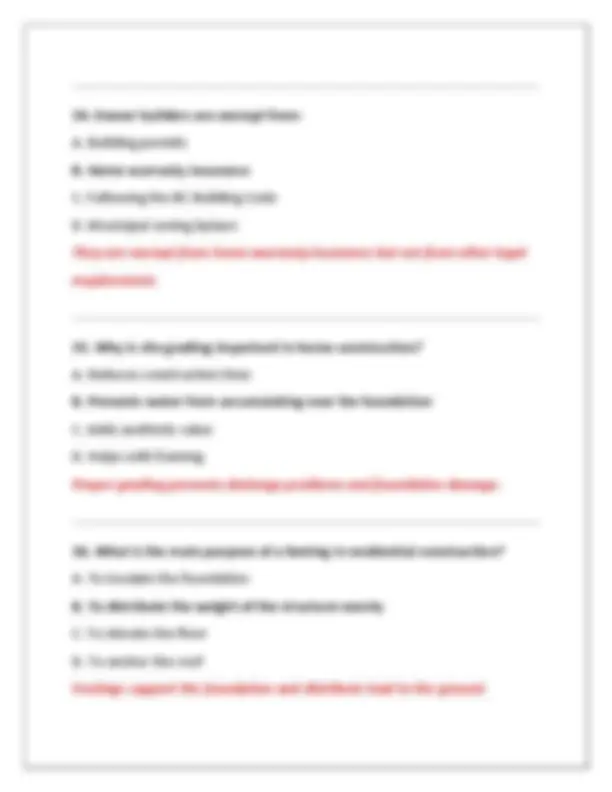
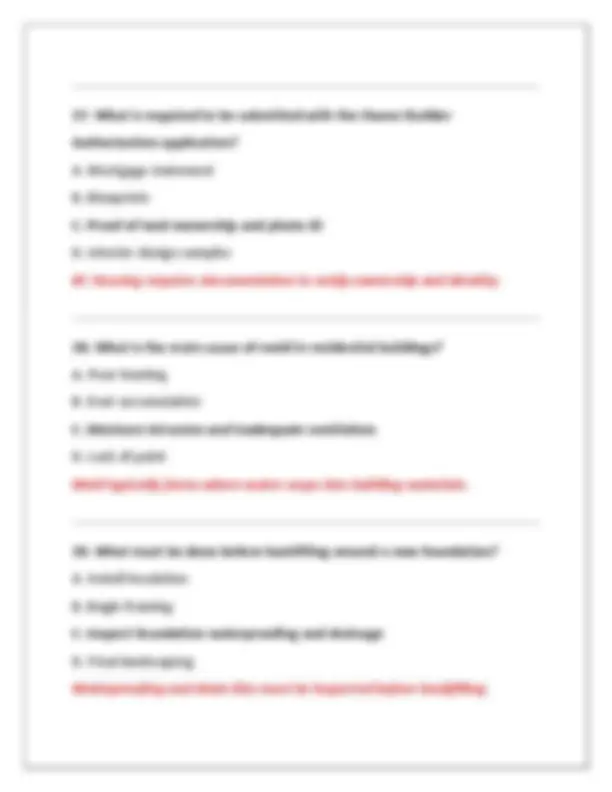
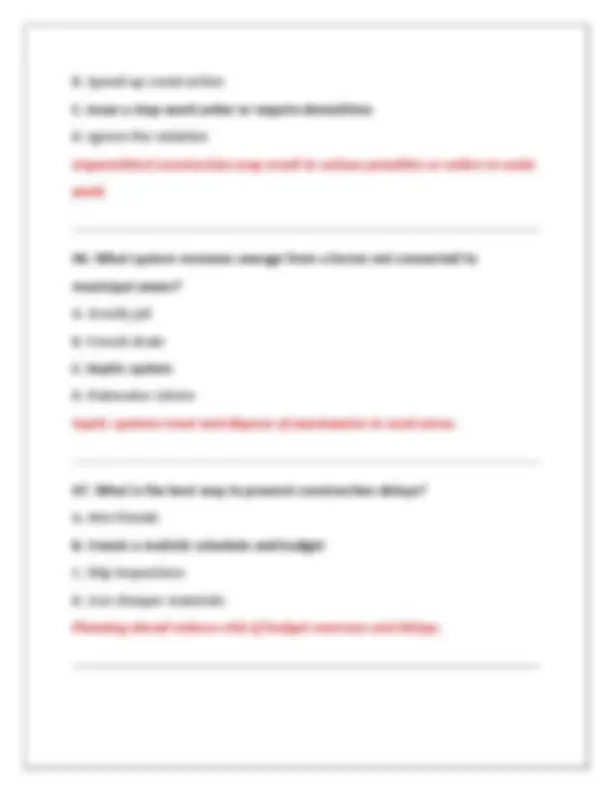
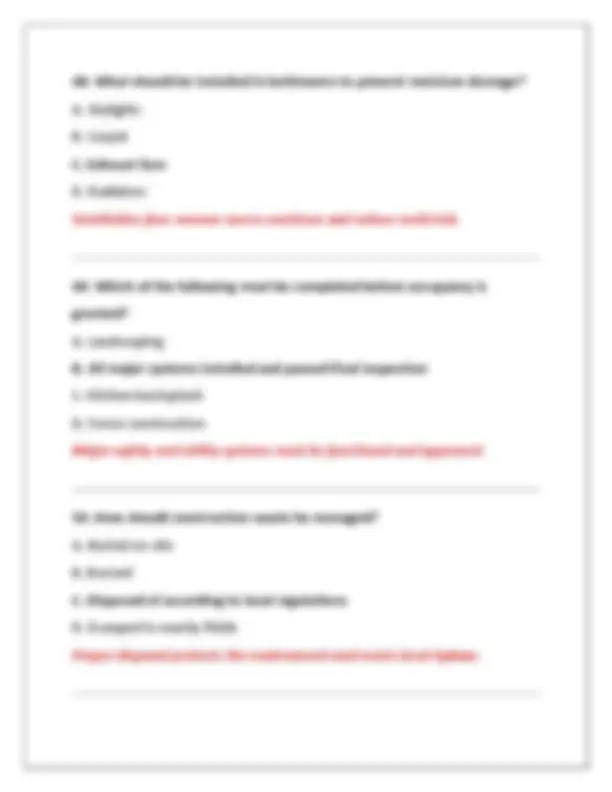
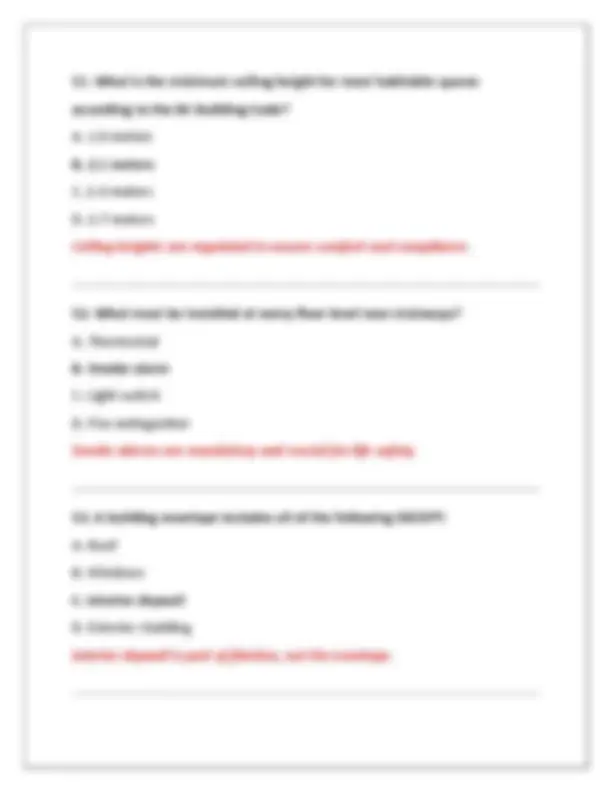
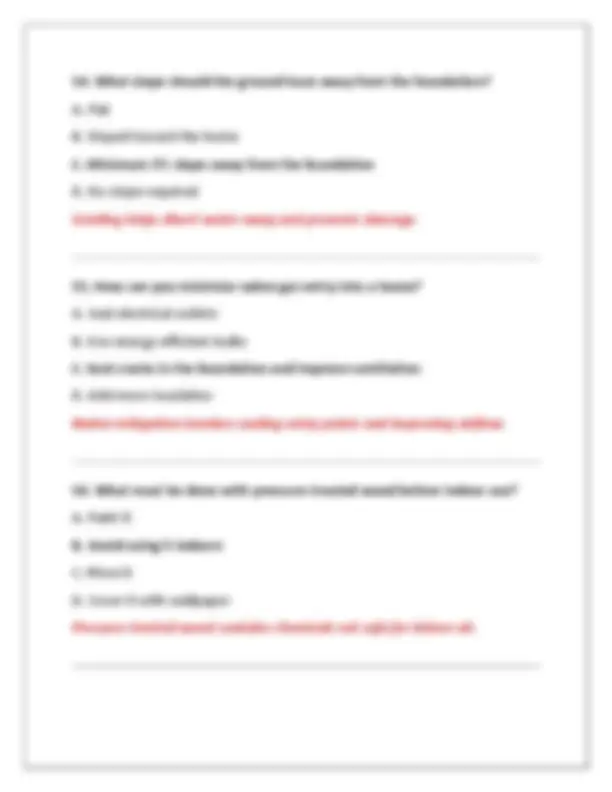
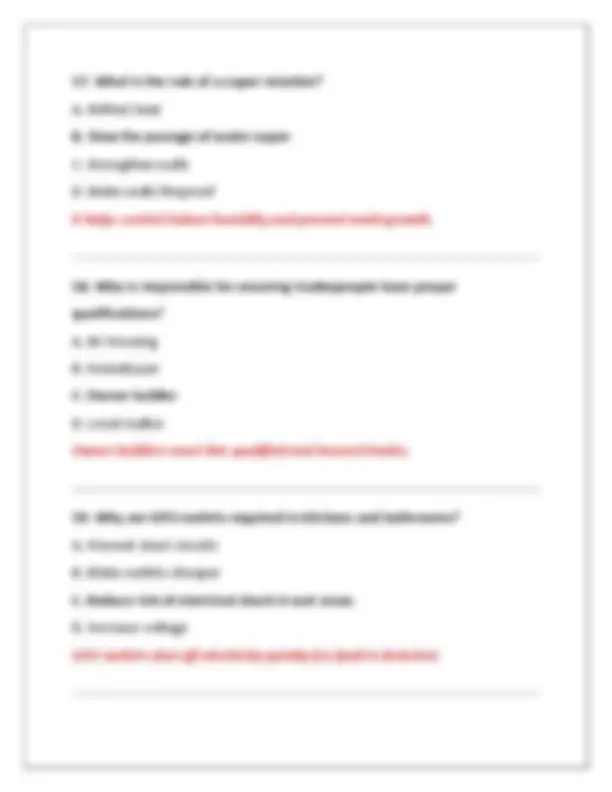
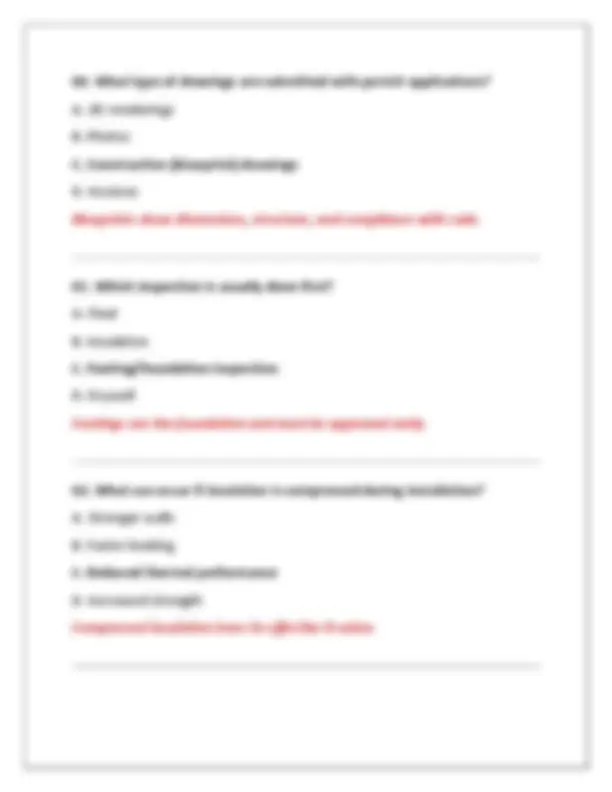
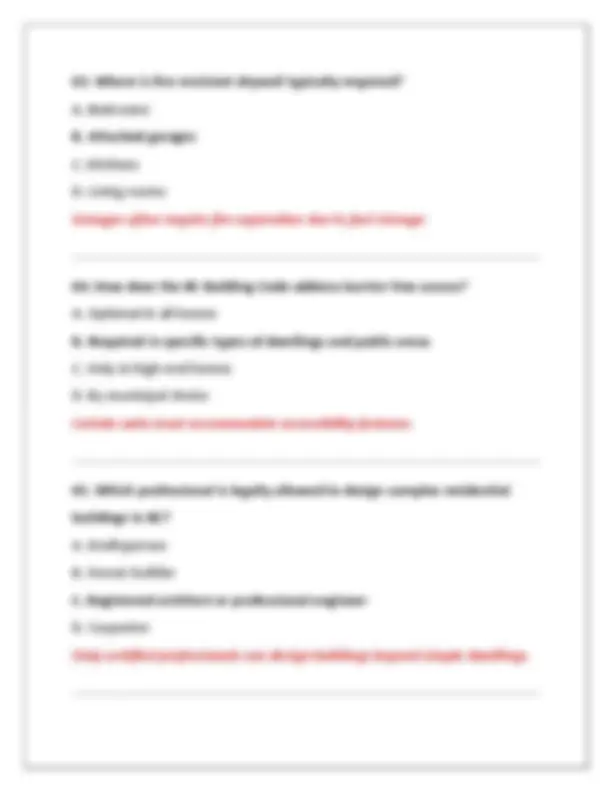
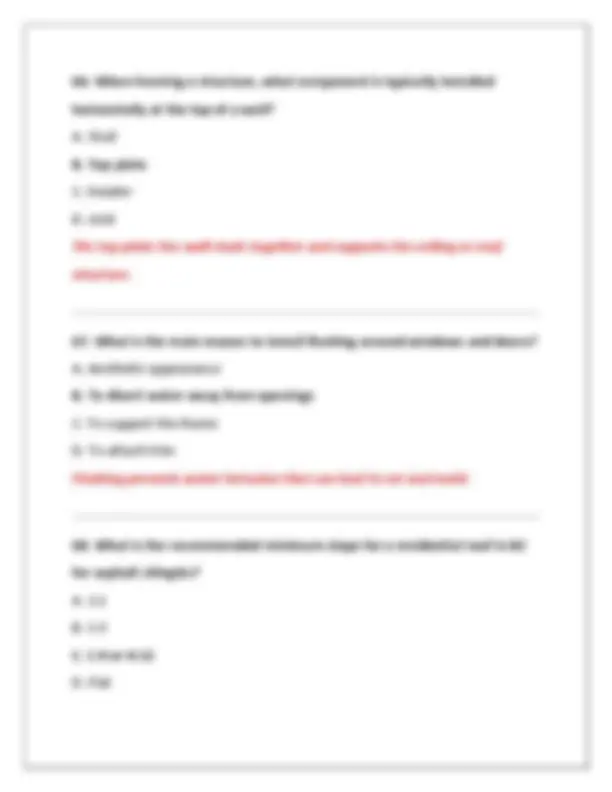
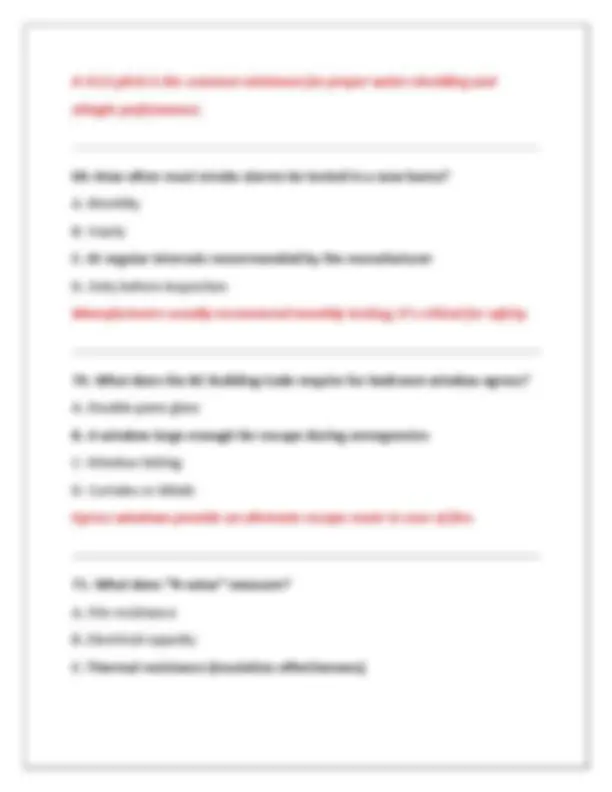
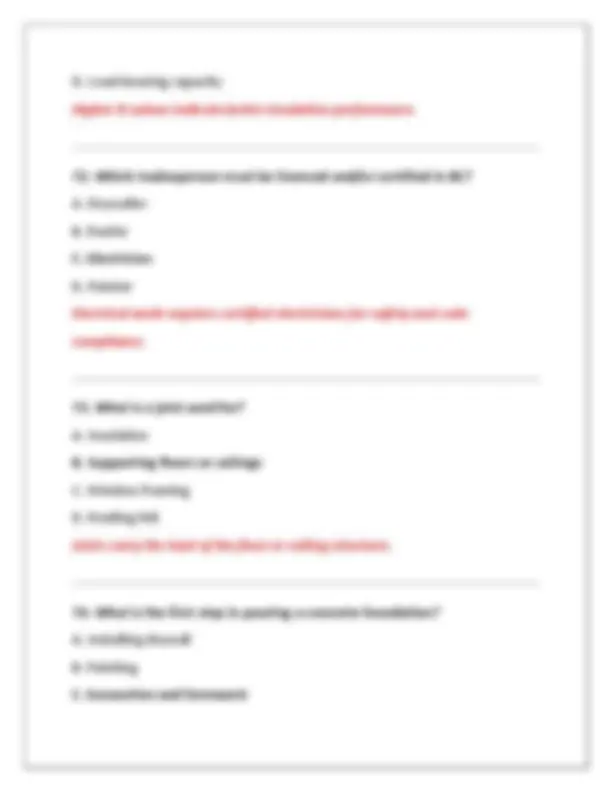
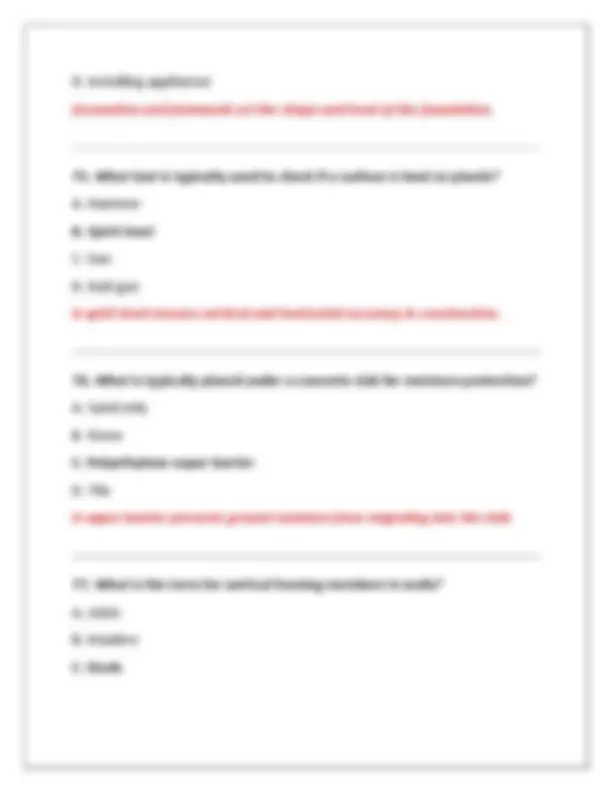
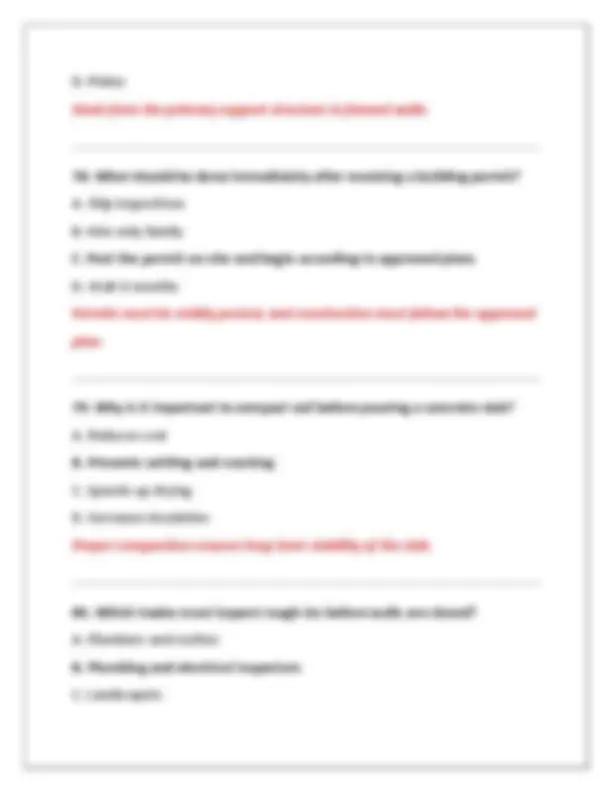
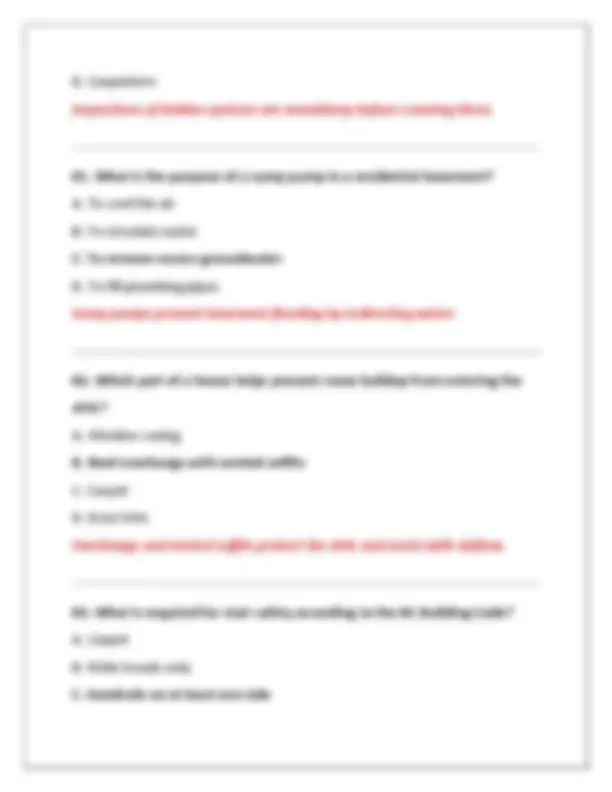
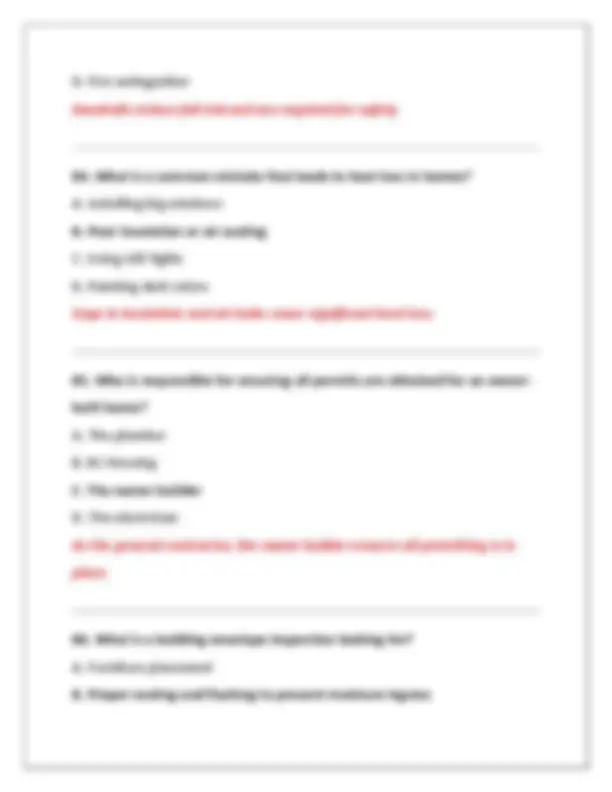
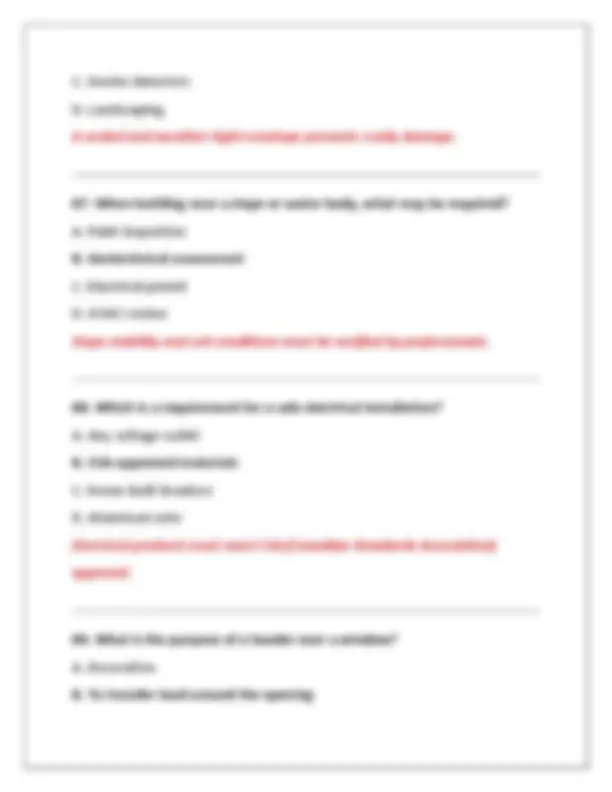
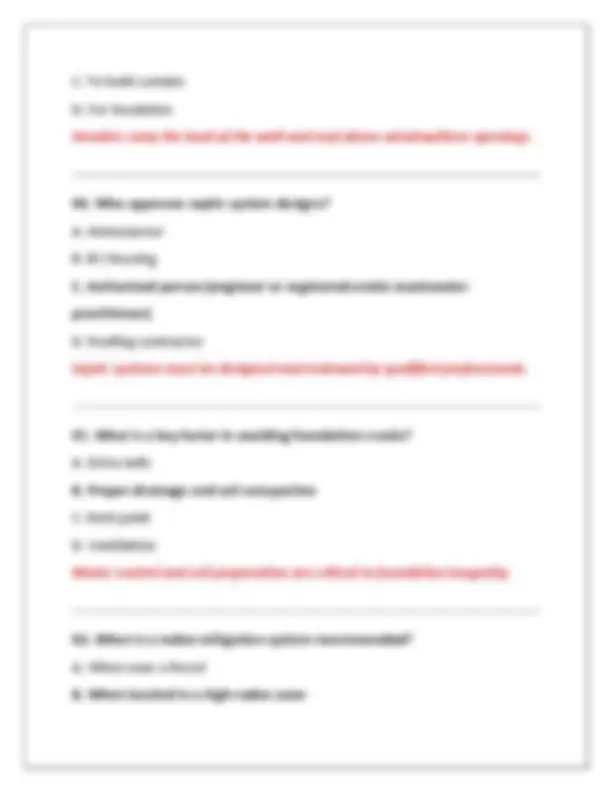
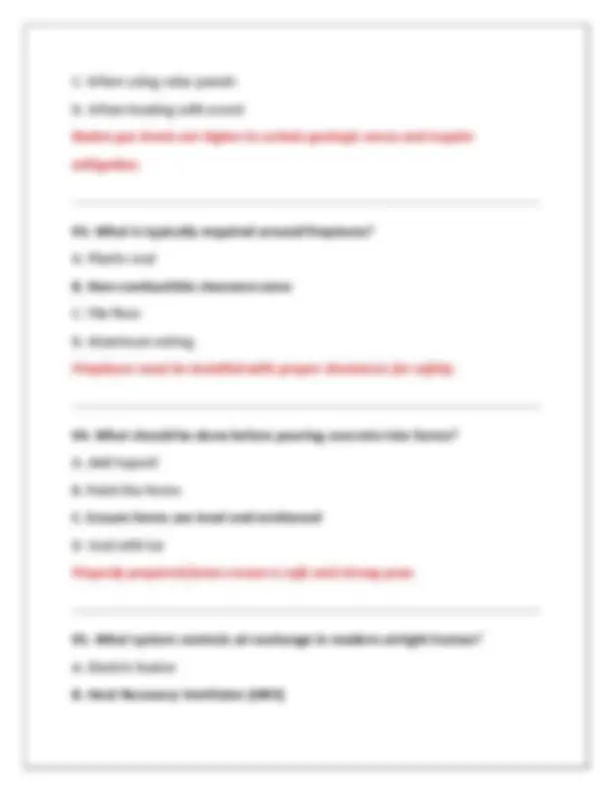
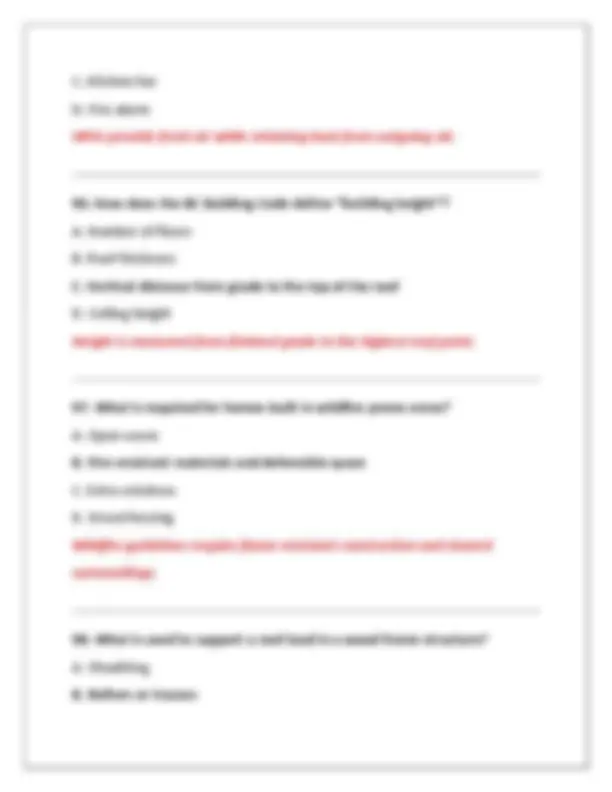
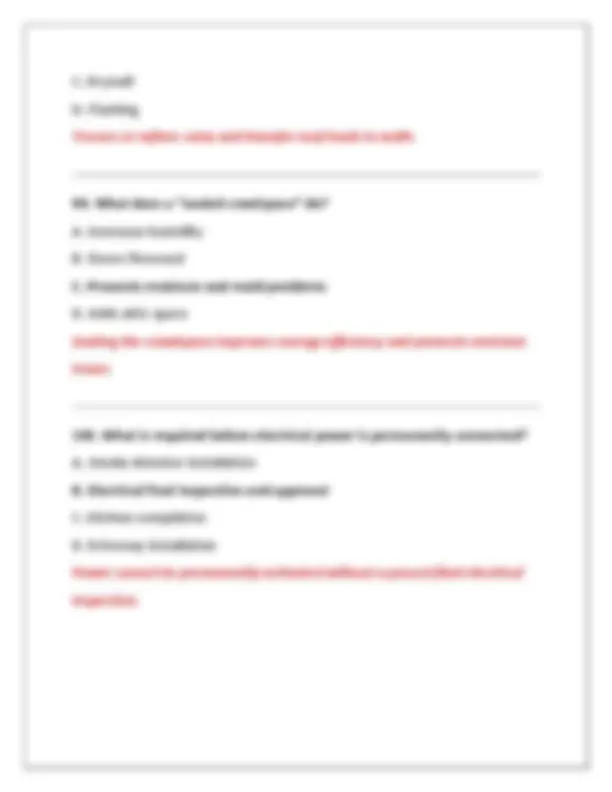


Study with the several resources on Docsity

Earn points by helping other students or get them with a premium plan


Prepare for your exams
Study with the several resources on Docsity

Earn points to download
Earn points by helping other students or get them with a premium plan
Community
Ask the community for help and clear up your study doubts
Discover the best universities in your country according to Docsity users
Free resources
Download our free guides on studying techniques, anxiety management strategies, and thesis advice from Docsity tutors
British Columbia BC Owner Builder Authorization Exam 2 Practice Questions And Correct Answers (Verified Answers) Plus Rationales 2025 Q&A | Instant Download PDF
Typology: Exams
1 / 36

This page cannot be seen from the preview
Don't miss anything!





























1. What is the primary purpose of the Homeowner Protection Act in British Columbia? A. To ensure only licensed contractors build homes B. To regulate property taxes C. To protect homeowners by setting standards for home construction and builder accountability D. To govern strata corporations The Act aims to protect homebuyers by improving the quality of residential construction and promoting accountability of builders.
2. An Owner Builder Authorization is valid for how many years from the date of occupancy? A. 5 years B. 10 years C. 2 years D. 7 years The Owner Builder Authorization includes a 10-year statutory warranty period. 3. What is the maximum number of Owner Builder Authorizations a person can receive in their lifetime? A. Unlimited B. One C. Two D. Three The Homeowner Protection Act allows an individual to build one home under an Owner Builder Authorization in their lifetime. 4. Who must live in the home constructed under the Owner Builder Authorization? A. A tenant B. The owner builder or their close family member C. A business partner
7. What building code must an owner builder follow when constructing a new home? A. National Building Code B. BC Building Code C. Vancouver Building Code D. Municipal Engineering Code The BC Building Code is the provincial standard for construction. 8. Who enforces the BC Building Code at the local level? A. BC Housing B. Ministry of Municipal Affairs C. Local government or building officials D. Contractor’s association Local governments are responsible for enforcing the BC Building Code through inspections. 9. When is a final occupancy inspection required? A. Before foundation work begins B. At framing stage C. Before the home can be legally occupied
D. After the electrical rough-in A home must pass final inspection to be deemed safe and habitable.
10. What happens if you begin building before receiving Owner Builder Authorization? A. You receive a warning B. You are fast-tracked C. You are in violation of the Act and may be fined D. Nothing Building without authorization is a legal violation and may result in penalties. 11. Which of the following does NOT qualify as a new home under the Act? A. A duplex B. A detached single-family dwelling C. A new basement suite D. A renovated kitchen in an existing home Only new dwellings are subject to owner builder requirements. 12. Owner builders must keep records of construction activity for how long? A. 5 years
15. What is one of the most common deficiencies identified in owner-built homes? A. Landscaping issues B. Building envelope problems (e.g., water ingress) C. Color mismatch D. Cabinet installation errors Building envelope failures are costly and commonly mishandled in DIY construction. 16. When applying for Owner Builder Authorization, which document is typically required? A. Marriage certificate B. Proof of land ownership C. Health insurance number D. Employment contract Proof of ownership is required to ensure the applicant is building their own primary residence. 17. Which of the following is NOT a component of the BC Building Code? A. Fire safety B. Structural integrity C. Vehicle registration
D. Plumbing and electrical standards The Building Code focuses solely on construction standards.
18. If you hire a subcontractor, what is your responsibility as an owner builder? A. Nothing B. Ensure they have WorkSafeBC coverage and required trade qualifications C. Let them handle permitting D. Pay in cash only Owner builders are considered "prime contractors" and must ensure compliance with safety and labor regulations. 19. What must be posted at the job site during construction? A. A “For Sale” sign B. An energy label C. A building permit D. A photo of the owner builder The building permit must be visible during construction. 20. What type of contract is recommended when working with tradespeople?
23. What must be included in a disclosure notice if the home is sold within 10 years? A. Color palette B. Construction date, owner builder status, and known defects C. Mortgage terms D. Cost breakdown Disclosure protects buyers and is a legal obligation under the Act. 24. What permits are typically needed before beginning new home construction? A. Parking permit B. Building permit and possibly electrical/plumbing permits C. Fishing license D. Business license Proper permitting ensures compliance and safety. 25. What is a common reason applications for Owner Builder Authorization are denied? A. Age B. Gender C. Previous authorization already used D. Style of the house Individuals may only build one home under this program in their lifetime.
26. What document must be obtained before construction begins on a new home? A. Zoning approval B. Warranty certificate C. Building permit D. Municipal tax receipt A valid building permit is mandatory before starting any residential construction. 27. Which organization regulates owner builder authorization in British Columbia? A. BC Building Safety Authority B. WorkSafeBC C. BC Housing (Licensing & Consumer Services Branch) D. Canada Mortgage & Housing Corporation BC Housing oversees licensing and consumer protection for owner builders. 28. What is the purpose of a vapor barrier in residential construction? A. Fire protection B. Soundproofing C. To prevent moisture from entering walls and ceilings
A. A completed landscaping plan B. Final inspection approval by local authorities C. A certificate of title D. An energy audit Final inspection ensures the home meets code and is safe for occupancy.
32. Who must complete the statutory declaration if the home is sold within 10 years? A. The realtor B. The buyer C. The owner builder D. The contractor The owner builder must complete the statutory declaration form as required by BC Housing. 33. What type of construction is NOT eligible under the Owner Builder program? A. Detached house B. Mobile home on a foundation C. Duplex built for resale D. Cabin used seasonally Homes built with the intent to sell or rent do not qualify under this program.
34. Owner builders are exempt from: A. Building permits B. Home warranty insurance C. Following the BC Building Code D. Municipal zoning bylaws They are exempt from home warranty insurance but not from other legal requirements. 35. Why is site grading important in home construction? A. Reduces construction time B. Prevents water from accumulating near the foundation C. Adds aesthetic value D. Helps with framing Proper grading prevents drainage problems and foundation damage. 36. What is the main purpose of a footing in residential construction? A. To insulate the foundation B. To distribute the weight of the structure evenly C. To elevate the floor D. To anchor the roof Footings support the foundation and distribute load to the ground.
40. What is typically used to insulate walls in BC homes? A. Steel wool B. Air C. Fiberglass or mineral wool batts D. Plastic wrap These materials are common for meeting thermal resistance (R-value) requirements. 41. What is the purpose of a building envelope? A. To contain heating systems B. To separate the indoor and outdoor environment C. To support the structure D. To enhance roof drainage The building envelope protects against moisture, air leaks, and thermal loss. 42. Who is legally responsible for any construction deficiencies in an owner-built home? A. The local inspector B. The owner builder C. Subcontractors
D. The engineer Owner builders are personally liable for construction quality and deficiencies.
43. Which inspection must occur before drywall is installed? A. Landscaping inspection B. Rough-in inspection (electrical, plumbing, framing) C. Final inspection D. Painting inspection Rough-ins must be inspected and approved before walls are closed up. 44. Which agency must an owner builder contact to set up a new electrical service? A. BC Housing B. BC Hydro C. FortisBC D. WorkSafeBC BC Hydro handles new electrical connections and metering. 45. If a home is built without proper permits, what can the local government do? A. Offer financial help
48. What should be installed in bathrooms to prevent moisture damage? A. Skylights B. Carpet C. Exhaust fans D. Radiators Ventilation fans remove excess moisture and reduce mold risk. 49. Which of the following must be completed before occupancy is granted? A. Landscaping B. All major systems installed and passed final inspection C. Kitchen backsplash D. Fence construction Major safety and utility systems must be functional and approved. 50. How should construction waste be managed? A. Buried on-site B. Burned C. Disposed of according to local regulations D. Dumped in nearby fields Proper disposal protects the environment and meets local bylaws.
51. What is the minimum ceiling height for most habitable spaces according to the BC Building Code? A. 1.8 meters B. 2.1 meters C. 2.4 meters D. 2.7 meters Ceiling heights are regulated to ensure comfort and compliance. 52. What must be installed at every floor level near stairways? A. Thermostat B. Smoke alarm C. Light switch D. Fire extinguisher Smoke alarms are mandatory and crucial for life safety. 53. A building envelope includes all of the following EXCEPT: A. Roof B. Windows C. Interior drywall D. Exterior cladding Interior drywall is part of finishes, not the envelope.